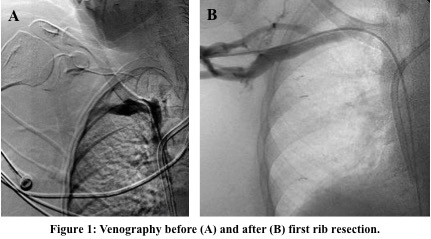First Rib Resection Can Facilitate Hemodialysis Access in Patients with Thoracic Outlet Syndrome
Kenneth R. Nakazawa, C. Y. Maximilian Png, Windsor Ting.
Icahn School of Medicine at Mount Sinai, New York, NY, USA.
OBJECTIVES: Intravascular catheters for hemodialysis are a common cause of central venous stenosis/occlusion. Meanwhile, thoracic outlet syndrome is an under-recognized contributing factor that may also affect long-term patency. We report a case of a patient who underwent thoracic outlet decompression via first rib resection to allow for ipsilateral creation of an arteriovenous graft.
METHODS: A 76-year-old woman on hemodialysis through a tunneled right internal jugular catheter underwent creation of a left brachial-basilic arteriovenous graft. The surgery was uncomplicated, but over the next 2.5 years she experienced swelling, dermatitis and pruritus around the surrounding skin. She also encountered several episodes of blood clots during dialysis, requiring multiple attempts at endovascular revision. The graft was finally excised when the patient developed ulcers near the cannulation site. With concern for central venous stenosis, we proceeded with venography and intravenous ultrasound to determine central patency prior to creating new permanent access.
RESULTS: Venography demonstrated left subclavian thrombosis and stenosis of the right subclavian vein between the clavicle and first rib (Figure 1A). Intravenous ultrasound showed stenosis in right subclavian vein to be very severe. Balloon angioplasty was suboptimal from underlying external compression, highly suggestive of bilateral thoracic outlet syndrome. Through a supraclavicular approach, we resected her right first rib to permit endovascular revascularization of the subclavian vein. Subsequent balloon angioplasty resulted in patent flow through the right subclavian and brachiocephalic veins (Figure 1B). We then created a new right brachial-basilic arteriovenous graft with good results for the past 6 months.
CONCLUSIONS: Correcting the etiology of central venous stenosis may be essential for establishing long-term hemodialysis access. In patients with underlying thoracic outlet syndrome, resection of the first rib can facilitate central venous patency necessary to create permanent, well-functioning access.

Back to 2018 ePosters




